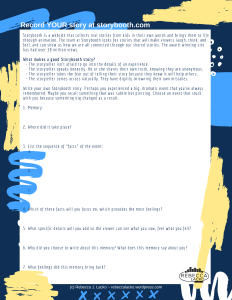
Please read my latest article on Huffington Post:
storybooth: How Sharing Stories Helps Kids (To Help Other Kids)
Seventh-grade student Carissa carried a painful memory around with her, but it wasn’t a secret. There were plenty of kids who witnessed (her now ex) boyfriend humiliate and verbally abuse her in the hallway at school. While the scene replayed in her head every day for the next year, she wouldn’t talk about it openly with anyone.
Carissa does have a secret, however. She’s a talented writer, and she explores her thoughts and personal challenges through short stories. This summer, she attended a free creative writers’ camp for teens at her local library. Every day, the students were provided writing prompts and mini lessons to create stories, poems, and scenes for novels-in-progress. This year, the students were introduced to storybooth (storybooth.com), a website that collects real stories from kids in their own words and brings them to life through animation. Kids of all ages are welcome to record their own personal experiences that made a lasting impact on their lives, whether positive, negative, or downright hilarious. It’s free, easy, and has the power to relieve a weighty burden – something that no other platforms for young people are doing. The act of recording a story is an effective means of letting it go, and not only that, the kids have a supportive community behind them.
The team at storybooth looks for stories that will make viewers laugh, think, and feel, and has a way of showing us how we are all connected through our shared stories. The award-winning site has over 100 million views, with multi-ethnic, compassionate and often humorous animations. But the most significant part of storybooth is the community response. As a digital platform unlike other social media sites, storybooth is an overwhelmingly supportive and safe place for kids to share their personal journeys. The peer comments are encouraging, understanding and uplifting.
When participants in the teen writing camp viewed several stories and took part in a short lesson on memoir writing, several felt empowered to put their own experiences into words. One student wrote about her family moving several times throughout her life and how difficult it is to say goodbye. Another talked about crashing a car through the family’s garage on his first day of driving school. (He’s still afraid to test for his license.) Carissa dared to read her story about the very public embarrassment that haunted her for months, discovering a sense of peace by dissolving the memory of its power. When kids reveal their authentic feelings, it can help other kids gain a fresh perspective on their own struggles.
What makes a good storybooth story?
- The storyteller allows him or herself to be vulnerable. They’re not afraid to go into the details of an experience.
- The storyteller looks at him or herself honestly. They expose their own truth, knowing they are anonymous and no one is judging.
- The storyteller takes the fear out of telling their story because they know it will help others.
- The storyteller comes across naturally. They are authentic, have dignity in owning their own mistakes, and just let themselves go.
For teens who are interested in visiting storybooth.com and sharing the story that’s been replaying through their head, simply visit storybooth.com, hit “record” – and then let it go. Those looking for some extra guidance can consider writing out the story ahead of time – the memoir writing exercise developed by the creative writers’ camp for teens is available here. If the story is chosen by the storybooth team, it’ll be animated and posted to the website. Other kids will have a chance to see the story and comment, and perhaps be inspired to write and record their own story.

